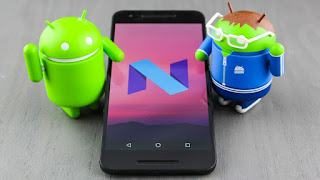 |
| Android N |
1) Android N will allow users to open two apps in split-screen mode on Nexus devices.
i.e. This means, for example, users can keep tweeting while watching a video on YouTube.
2) Android N brings with it more Quick Settings when you slide the notifications pane down.
3) Android N may help solve this, courtesy the new feature called 'Bundled notifications'. With this feature, users can group together notifications from each app in the menu and one will just need to tap the bundle to read individual alerts.
4) Android 7.0, Doze will work not only when your phone is not in use, but also when the screen is turned off. This is expected to improve the battery life.
5) In Android N double-tapping the Recent Apps button from homescreeen will open the last-used app, while double-tapping the button when an app is already open will take you to the app you had open just before.
6) Android N native file browser are: hamburger menus, searchability by file types and folders, the option to move and share files, and Google Drive integration. You can even have multiple instances of the file browser open at the same time.
7) Android N allows users to block phone numbers at the system level, directly from apps like Dialler, Hangouts or Messenger.
8) Android N provides the ability to add your medical information on the lockscreen itself in case of an emergency. You can go to Users in Settings and select the Emergency Information option; fill the details you want to reveal and add an emergency contact for good measure.
9) Android N brings a few changes that can be found in the Settings app under different menus. These include a new night theme, data saver that blocks background data consumption, and provision for display calibration as well as screen zooming, among others.




